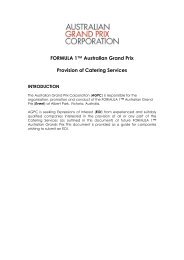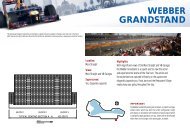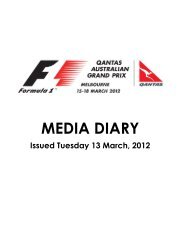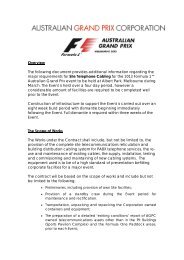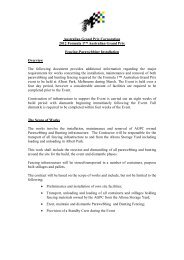2013 AnnuAl RepoRt - Australian Grand Prix
2013 AnnuAl RepoRt - Australian Grand Prix
2013 AnnuAl RepoRt - Australian Grand Prix
Create successful ePaper yourself
Turn your PDF publications into a flip-book with our unique Google optimized e-Paper software.
Notes to and Forming Part of the Financial Statementsfor the Financial Year Ended 30 June <strong>2013</strong>or loss upon recognition may be reclassified out of the fair value through profit or losscategory, if they are no longer held for the purpose of selling or repurchasing in the nearfuture.Financial instrument assets that meet the definition of loans and receivables may bereclassified out of the fair value through profit and loss category into the loans andreceivables category, where they would have met the definition of loans and receivableshad they not been required to be classified as fair value through profit and loss. In thesecases, the financial instrument assets may be reclassified out of the fair value through profitcategory, if there is the intention and ability to hold them for the foreseeable future or untilmaturity.(l)Financial AssetsCash and depositsCash is held at call with Treasury Corporation of Victoria and other financial institutions.For the purpose of the Cash Flow Statement, cash and cash equivalents includes notes andcoins held, cash at bank and deposits with a maturity of 3 months or less, which are readilyconvertible to cash on hand and are subject to insignificant risk of changes in value.ReceivablesReceivables consist predominantly of debtors in relation to goods and services and accruedinvestment income that are not quoted on the active market.Receivables that are contractual are classified as financial instruments. Statutory receivablesare not classified as financial instruments.Receivables are initially recognised at fair value plus any attributable transaction cost andsubsequently measured at amortised cost using the effective interest method less anallowance for impairment.A provision for doubtful receivables is made when there is objective evidence that the debtsmay not be collected and bad debts are written off when identified.Impairment of financial assetsAt the end of each reporting period, the Corporation assesses whether there is objectiveevidence that a financial asset or group of financial assets is impaired. All financial instrumentassets, except those measured at fair value through profit and loss, are subject to annualreview for impairment.Receivables are assessed for bad and doubtful debts on a regular basis. Those bad debtsconsidered as written off by mutual consent are classified as a transaction expense. Baddebts not written off by mutual consent and the allowance for doubtful receivables areclassified as ‘other economic flows’ in the net result.The amount of the allowance is the difference between the financial asset’s carrying amountand the present value of the estimated future cash flows, discounted at the effective interestrate.In assessing impairment of statutory (non-contractual) financial assets, which are not financialinstruments, professional judgement is applied in assessing materiality using<strong>Australian</strong> <strong>Grand</strong> <strong>Prix</strong> Corporation Annual Report <strong>2013</strong> 3939



